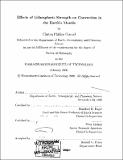Effects of lithospheric strength on convection in the Earth's mantle
Author(s)
Conrad, Clinton Phillips, 1971-
DownloadFull printable version (25.51Mb)
Other Contributors
Massachusetts Institute of Technology. Dept. of Earth, Atmospheric, and Planetary Sciences.
Advisor
Bradford H. Hager and Peter Molnar.
Terms of use
Metadata
Show full item recordAbstract
Convection in Earth's mantle is driven largely by horizontal density gradients that form when cold, dense, mantle lithosphere descends into the mantle interior, either through subduction for plate-scale flow, or as localized convective instability beneath lithospheric plates. The deformation associated with these processes is resisted by the extreme temperature-dependence of the lithosphere's strength. Ways in which lithosphere deformation affects convection in the mantle are examined here, by comparing both theory and the results of numerical experiments. Convective instability at the base of a cold thermal boundary layer with temperature and strain-rate-dependent viscosity is investigated by defining a quantity, termed here the "available buoyancy," that takes into account the tradeoff between cold temperatures both promoting and resisting convective instability. This quantity can be used to determine approximately whether, and how fast, convective instability grows. Horizontal shortening is also included, which tends to increase gravitational instability, allowing up to 60% of the mantle lithosphere to be convectively removed. The subsequent influx of hot, buoyant, asthenosphere could cause rapid surface uplift. For plate-scale flow, subduction zone deformation may resist convection. This possibility is studied here using a regional finite element model of subduction. This model shows that for sufficiently strong lithosphere, convection is resisted more by the bending deformation of a subducting plate than by shearing of the underlying mantle. Such behavior can be explained by a variation of boundary layer theory that includes an analytic expression for the energy required to bend a viscous plate. For the mantle, the bending resistance should control plate velocities if the effective lithosphere viscosity is greater than about 1023 Pa s. This produces a reasonable distribution of plate velocities for Earth and may reconcile models for its thermal evolution with surface heat flow observations. These results are verified using a new method for implementing subduction that parameterizes plate bending within a small region of a mantle-scale convection model. This model also shows that small-scale convection, by removing the basal part of the oceanic lithosphere, can decrease the bending resistance and thus may be an essential aspect of plate tectonics on Earth.
Description
Thesis (Ph.D.)--Massachusetts Institute of Technology, Dept. of Earth, Atmospheric, and Planetary Sciences, February 2000. Includes bibliographical references (p. 235-244).
Date issued
2000Department
Massachusetts Institute of Technology. Department of Earth, Atmospheric, and Planetary SciencesPublisher
Massachusetts Institute of Technology
Keywords
Earth, Atmospheric, and Planetary Sciences.